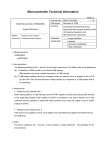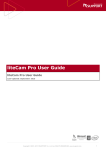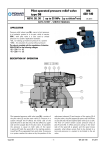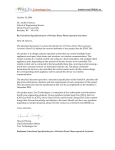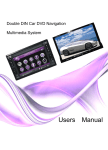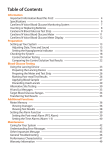Download V850 V850ES Improves BGM Designs
Transcript
APPLICATION NOTE V850 Renesas V850 MCU Improves BGM design R01AN0213EU0100 Rev.1.00 May 13, 2011 Introduction A Blood Glucose Meter (BGM) is a portable electronic device that automatically measures the level of blood glucose to simplify the treatment of Type 1 diabetes (the type controlled via insulin) and to provide Type 2 diabetes patients with information to help control their diet (the main form of treatment for Type 2). The device is appropriate for use in the home and thus reduces the need for routine medical visits related to glucose monitoring. Additionally, advanced units can provide measurement data to medical services automatically, via a wireless link, so that a complete history of measurement data is available when medical visits do occur. This detailed and precise history can be invaluable in diagnosing illness, identifying preventative treatment options and in tracking the progression of long-term illness. The design of an effective BGM device must incorporate a wide range of functions: sensing of the blood sample, computation to determine the glucose level in the blood, categorization of the measured result, logging of the stored data, communication of the stored data to a medical service for follow-up consultation and a simple user interface to display instructions, results and control BGM operation. Some designs might include an audio function to provide prompts (either simple ‘beeps’ or via speech generated audio for visually impaired patients) that simplify device operation. Because the BGM is to be used in the home, during travel or at the workplace it is important that it be small, and use as little power as possible. Minimizing recharge and other ‘out of operation’ times is critical to providing regular and easily accessed use, which is necessary for successful treatment. BGM devices can also be extended to measure other blood components like ketones which are produced during hyperglycemia. Measurements of other blood components can simply require a different test strip, with a different active chemical. The BGM, which is now a more generic blood element meter, can be used to measure the amount of the component using the same electronics. This application note will cover the key features and functions required by a BGM device and will explore the capabilities of the Renesas V850ES MCU that address these application requirements. The overall architecture of an example BGM implementation will be developed and some of the key supporting functions- both in hardware and software- will be described in detail. Key performance and power measurements will be included to help give the reader a good understanding of the ability of the Renesas V850ES MCU to hit the power efficient processing requirements of the application. Target Device V850ES/JG3-L Table of Contents 1. Blood Glucose Monitor Theory of Operation..................................................................................... 2 2. BGM Operation Requirements.......................................................................................................... 2 3. Renesas V850ES Peripherals used in BGM Design ........................................................................ 7 4. BGM Example Design with the Renesas V850ES MCU................................................................. 14 5. Conclusion....................................................................................................................................... 19 6. References ...................................................................................................................................... 19 R01AN0213EU0100 Rev.1.00 May 13, 2011 Page 1 of 20 V850 1. V850ES Improves BGM Designs Blood Glucose Monitor Theory of Operation A Blood Glucose Meter (BGM) is a medical device for measuring the concentration of glucose in the blood. It is one of the key elements in the home blood glucose monitoring regime used by people with diabetes mellitus or hypoglycemia. A small drop of blood, usually obtained by piercing the skin with a special sampling needle (a lancet), is placed on a single-use test strip that the meter uses to determine the samples blood glucose level. After just a few seconds, the meter displays the level in mg/dl or mmol/l to assist the user in determining the correct action to keep their glucose level within the desired range. The metering process is typically done several times a day so that the target blood glucose level stays within the desired range all day long in order to more effectively manage type 1 diabetes and type 2 diabetes mellitus. This can reduce the occurrence rate and severity of both the long-term complications from hyperglycemia and the short-term, potentially life-threatening complications of hypoglycemia. Figure 1 shows four different generations of BGMs, and illustrates the improvements in size reduction and simplified ease of use. Modern BGMs require much smaller blood samples, include lancets with adjustable depth to minimize discomfort during sample collection, improved accuracy and speed of results, and include comprehensive data logging and averaging functions to help track long term trends. Some systems can upload a history to a medical service to advise the patient’s doctor of changes in glucose levels which might identify complications. Figure 1: Example Blood Glucose Meters- Four Generations 2. BGM Operation Requirements A modern BGM must support several key features to be competitive in the marketplace. Perhaps the most critical requirements are in these three key areas: the monitoring and computation used to determine the patient’s blood glucose level and to recommend the right treatment; the logging and communication of measurement data to create a history of results for use in long term preventative care; the user interface needed to simplify device operation and display of results; and the device needs to operate in a variety of low power modes to extend battery life as much as possible. These key requirements will be expanded on in the following sections so we can better identify the key components and features needed in our design. 2.1 Glucose Metering Requirements In order to better understand the requirements of blood glucose metering a quick review of the technique used to detect blood glucose is useful. This technique can also be extended and used in a variety of other meters. Blood alcohol, gasses, in-organic compounds and even radiation are just a few examples. Figure 2 shows a diagram of a typical four step process used to measure the blood glucose level. In the first step a small sample of blood, containing Glucose (G) is deposited on the test strip. The blood is routed to the electrodes via capillary action. Step 2 shows the circuitry attached to the electrodes and the presence of the Mediator (M) enzyme on the test strip prior to the blood reaching the electrodes. As illustrated in Step 3, the enzyme will react with the blood glucose (once the blood has moved down the test strip to R01AN0213EU0100 Rev.1.00 May 13, 2011 Page 2 of 20 V850 V850ES Improves BGM Designs the location with the enzyme near the electrodes) to create free electrons (e). The free electrons can be moved thru a circuit (in this example when the switch is closed) when a voltage is applied between the two electrodes. The current flow can be measured by a meter (A) in the circuit. The amount of charge that moves thru the circuit will be representative of the blood glucose level in the sample. By integrating the current flow the total charge can be measured and the blood glucose level calculated. The metering process typically only requires a few seconds- most modern BGMs report results in less than 5 seconds- since the processing power required by the BGM is not extensive. Figure 2: Example Blood Glucose Measurement Process There are several refinements possible to the basic example given here. Once we get into the example implementation section of this document some of these refinements will be described and implemented. Typically they only require additional analog sensing channels, so the basic description given here is sufficient to understand the following description of the analog sensing requirements of the BGM device. 2.1.1 Analog Sensing Requirements In a typical BGM device there are a small number of electrodes used to measure the current generated by the test system described above. These electrodes can be sensed by a variety of methods, but an Analog to Digital converter is usually employed to convert the analog measurement to a digital value so it can be used in a numeric algorithm to determine the amount of blood glucose present. The amount of current generated is typically around 10uA at the maximum point and a simple conversion circuit is used to translate the electrode current into a voltage that can be easily measured by the R01AN0213EU0100 Rev.1.00 May 13, 2011 Page 3 of 20 V850 V850ES Improves BGM Designs AtoD converter. Because of the chemical reaction time, the current measurement takes a few second to complete. Given that, a modern MCU with ADC with conversion times ranging from 5μS to 25μS is more than sufficient. In addition to the current measurements described above, some additional sensor requirements can be added to the design. For example, it is convenient to measure the presence of the test strip to make sure it has been inserted completely. Since the measurement location of the blood sample is inside the meter, it is usually difficult to visually determine if the strip is inserted completely. Some strips have registration markings to help improve strip placement, but these are usually too small for the visually impaired. A simple sensor can be added to detect the presence of the strip using an additional AtoD channel, so many designs include this feature. Alternately, many strip designs use a shorting connector and GPIO to detect strip insertion. Since each test strip has its own calibration code (due to the variations within processing batches) to improve measurement accuracy it can be a requirement that the user input the test strip calibration code. Many test strip containers include a small coding key that can be inserted into the BGM. These keys can use different resistance levels on each of the key ‘fingers’ to make it easy to read the value with a few extra AtoD converters or with a small amount of additional external circuitry to ‘multiplex’ these values to a single AtoD sense input. Some advanced meters also include temperature monitoring since the method used to determine blood glucose levels can vary based on the temperature. A simple thermistor (a temperature sensitive resistor) and an AtoD channel can be used to measure the temperature near the electrodes within the BGM device. 2.1.2 Computation Requirements Modern BGM devices require some basic computation functions in order to determine the results of a blood glucose measurement. Many BGM companies have more sophisticated techniques which are proprietary and are part of the Intellectual Property (IP) embodied in their design. The typical response current from the example BGM sensor circuit shown in Figure 2 above is given in Figure 3 below. The various phases of the response are: 1) Test Strip in inserted and a DC voltage is applied between the electrodes. 2) The blood sample is placed on the test strip and the blood begins to react with the enzyme to generate a current. 3) After the reaction ends the current begins to drop off. During this phase the current is diffusion controlled. 4) After 5 seconds has elapsed sensing is complete and results can be computed. Figure 3: Typical BGM Response Current Profile During the diffusion controlled step (3) the waveform shows a predictable downward decay that is defined by the Cottrell Equation. This equation related the change in current over time, I(t), as a function of the number of electrons, Faradays constant, the area of the electrode, the initial concentration of the substance under measurement and its R01AN0213EU0100 Rev.1.00 May 13, 2011 Page 4 of 20 V850 V850ES Improves BGM Designs diffusion coefficient. (The diffusion coefficient varies with temperature, but with a know temperature can be treated as a constant). The full Cottrell Equation is given in Equation 1, below: I(t) = -nFACo*Do1/2(πt)-1/2 Equation 1: Cottrell Equation for Determination of Current Over Time The MCU can compute the current during the Cottrell period by periodically measuring the voltage on the AtoD converter. Once the current is known over the period the Cottrell equation applies the number of electrons can be determined by solving the equation for n. The MCU will have bandwidth to make this computation within the time required. Adjustments can be made to eliminate various biases (for example if there are temperature changes or impurities in the sample) to improve accuracy, but the use of the Cottrell equation is the baseline for most measurement algorithms. The timing of data collection can be critical in creating an accurate picture of the current changes over time. If hardware timers are available that can be used to accurately capture AtoD conversion data periodically, without the need for CPU intervention or time variable interrupt routines, accuracy in current measurement will improve. Precise time intervals will insure that the time element is not a significant source of measurement errors. 2.2 Data Logging and Communication Requirements Once the current measurement has been made and reported to the user it is important that the data not be lost. Logging the measurement data and using it to identifying trends over long periods can be critical to improving home care and minimizing unnecessary visits to the doctor. Trend data can also be useful during a periodic doctor visit or might even be collected by a medical service so that the doctor can periodically check on patients results without needing a visit to the clinic. More advanced systems might even issue alerts to the clinic if results indicate a change in treatment is required. A communications system that allows the off-loading of logged data would be a critical component of this type of advanced care system. 2.2.1 Data Logging Data storage is important in order to store all the key data acquired during BGM use. This can include the basic result (value and time of test) as well as more detailed metrics on the shape of the response curve, test strip production batch numbers, self test and calibration readings. These more advanced readings might be useful for the manufacturer in refining measurement algorithms, making updates to calibration routines and in determining the results of aging on the elements of the system. Compression techniques could be used to store more data in a smaller memory. Data is typically stored in non-volatile memory in FIFO fashion and can’t be accidentally erased or modified by the operator. It is made available for to be downloaded to archival storage or displayed on the user interface in the form of averages over specified time intervals or as graphs showing trends and long term changes in measurements. 2.2.2 Communications Some key communications requirements can be identified for a full featured BGM device. The stored data can be made available via a standard interface (USB for example) so it can be downloaded to a personnel computer or cell phone. Once stored on a personnel computer the data can be archived and further processed to determine long term trends (longer than the typical 500 or so measurements stored on the BGM). Trend data can be sent to a medical service or clinic to monitor patient performance and alert the patient of any recommended changes in the treatment. More detailed data including calibration, bias measurements and self-test data could be used by the manufacturer to make changes in calibration routines and adjustment coefficients used by the blood glucose measurement algorithms. These changes can be uploaded to the BGM to cancel aging and other effects that would create errors in future measurements. Additionally, the BGM can be tailored more specifically to the patient and biases due to differences in diet, the environment or activity levels can all be adjusted to further improve measurement accuracy and treatment recommendations. USB is only one possible communications protocol that a BGM could use. Infrared or Bluetooth are also possible communications methods that could be used by advanced BGM devices. When a personnel computer is not available a cell phone could be used to capture logged data and to send it to a clinic. This might even be the preferred communication method for some users and could reduce the time a patient needed to spend on their daily routine. R01AN0213EU0100 Rev.1.00 May 13, 2011 Page 5 of 20 V850 2.3 V850ES Improves BGM Designs User Interface Requirements Besides the main function of glucose measurement the BGM should also make it easy for the user to make measurements, check on the time for the next measurement, view measurement history, determine the results of measurements, and maximize battery life, all with a small and convenient design. A simple user interface with a clear display is an important factor in improving device usability and must be a key element integrated into the overall design. In order to produce more accurate results, devices can also include self-test functions, calibration functions using samples with known blood glucose levels and can include measurements of environmental factors such as temperature to adjust the metering algorithms and adjust for component aging effects. Typically each batch of test strips has different characteristics and the BGM must be correctly calibrated for each batch. The batch number can either be entered into the BGM manually or can be read off a special key included with each vial of strips. The key is inserted into the BGM and the calibration code is displayed prior to each test so the operator can compare the calibration value to the one listed on the vial. An example of a key-based coding system is diagrammed in below Figure 4 . This example uses the small key (with the code 237 printed on it, shown in the upper left of Figure 4 ), that is included in the vial of test strips (shown in the bottom left of Figure 4 ). The user inserts the key and then before each test compares the key value (shown on the BGM display in Figure 4 ) to the value printed on the container. Figure 4: Example Key-based Coding System In some devices it can be useful to have an audio alarm or alert function. This can indicate the time to take a measurement or the result of a measurement outside of the normal range. Specialized units could even provide the result via speech synthesis for the visually impaired. Many modern units also keep the history of the last measurements, usually a few hundred, and can show graphs or averages over several useful time intervals. These reports can help identify long term trends and identify possible changes in health that could be difficult to catch when results are only viewed over the short term. The user interface should make it easy to view these reports with a minimum of operator intervention. It is useful for the BGM to also include a time of day function to make it convenient for the user to know when to take a measurement and so the BGM can include a time of day function also supports time-stamping data for data logging, ensuring proper clinical analysis of the measurement. A hardware-based Real Time Clock (RTC) makes the implementation of a clock function easy and reduces the CPU processing burden. 2.4 Low Power Requirements When the BGM is not in use, it only needs to keep track of a real time. In this operating mode, it is desired to have the entire system turned off, except the Real Time Clock which tracks the real time. Even in RUN mode, there are times for high processing and low processing. A flexible clock with easy transition between different operation frequency can tailor to power consumption. For example, running USB would put MCU at max frequency, while actual processing may run at 8Mhz. During the design implementation we will explore the ways we can use low power modes to reduce power consumption and will provide some measurements for an example design. R01AN0213EU0100 Rev.1.00 May 13, 2011 Page 6 of 20 V850 2.5 V850ES Improves BGM Designs Small Footprint Requirement The BGM should be able to be carried easily in a pocket or small purse. Targeting a system with the size of a cell phone is a key requirement. If the BGM is not easy to carry around it will not be used as much as it needs to be. Thus the size of the BGM is important and the design should focus on reducing the number of device components and use devices in small sizes (such as FBGA), resulting in a small circuit board, to achieve a portable form factor. NOTE the display size must take into consideration use by the visually impaired, and may even include small speaker to announce Glucose readings. 3. Renesas V850ES Peripherals used in BGM Design The Renesas processor product line is very extensive with a wide range of features and target applications. For a BGM design it will be important for the processor to address the key requirements described in the previous section. A list of the key requirements is given below: 1) Analog to Digital conversion support for sensor inputs 2) Digital to Analog conversion for audio output 3) User interface support for LCD display 4) Peripheral support for USB 2.0 5) DMA support to off load the processor from the mundane work of moving data between peripherals and memory 6) Hardware counters and times (including watchdog timer, real time clock and timers for controlling analog capture and generation) 7) Small device size- FBGA package preferably 8) Support for computation functions 9) High quality and secure Flash with Error Correction Code 10) Robust software support The V850ES/Jx3-L with USB line of devices that provide the low-power operation, peripheral set, small device footprint (8x8 FBGA) and processing power required for our example BGM design. The amount of on-chip RAM and Flash Memory required will be in the range of 256KB-512KB of Flash and 40KB of RAM so the V850ES/JG3-L is a good fit for our design. 3.1 V850ES/JG3-L Architecture Overview and Block Diagram The V850ES/JG3-L is a 32-bit single-chip microcontroller that includes the V850ES CPU core and peripheral functions such as ROM/RAM, timer/counters, serial interfaces, an A/D converter, a D/A converter, and USB function controller. In addition to high real-time response characteristics and the basic one clock cycle instructions, the V850ES/JG3-L features multiply instructions, saturated operation instructions, and bit manipulation instructions. It is an optimal solution for real-time control, PC peripheral devices, or industrial instruments. Let’s look at the key hardware elements of the V850ES/JG3-L prior to diving into the description of the BGM high-level architecture. 3.1.1 V850ES/JG3-L Architecture Description The V850ES/JG3-L key hardware elements are illustrated in Figure 5, below. The peripheral set is comprehensive and includes System Management, Analog, Timers and Communications hardware. System Management functions include a Bus Control Function that manages the general purpose I/O ports, a four-channel Direct Memory Access Controller (DMAC) that supports both internal and external transfer requests and a Standby mode controller that manages the seven low power operation modes. Analog functions include twelve channels of 10-bit resolution Analog to Digital Converter (ADC) with 5uS minimum conversion time, and two channels of 8-bit resolution Digital to Analog Converter (DAC) with 3us minimum conversion time. Timer functions include three 16-bit General Purpose timer/counters (GP Timers) each with multiple channels, a Watchdog Timer (WD Timer) that issues a system reset or interrupt on overflow, a clock generator (Clock) that creates the various clock signals used by the CPU and peripherals, and a Real Time Clock (RTC) to keep track of the time and date. R01AN0213EU0100 Rev.1.00 May 13, 2011 Page 7 of 20 V850 V850ES Improves BGM Designs Communications functions include a Universal Serial Bus (USB) function controller, seven channels of Asynchronous Serial Interface (UART), and three channels of Inter IC (IIC) communications bus. Figure 5: V850ES/JG3-L Key Hardware Blocks 3.2 Detailed Description of Key Common Hardware Blocks In order to better understand our BGM implementation it is necessary to describe the operation of several of the key hardware blocks of the V850ES/JG3-L. These blocks will be used to implement the required features of the BGM device. 3.2.1 ADC A block diagram of the key elements of the V850ES/JG3-L is shown in Figure 6. It has 12 analog inputs, 12 storage registers (ADA0CR[0:11] for the converted data, an analog selector, sample and hold circuit, comparator, and a 10-bit D-to-A converter used by the successive approximation register to determine the value on the selected analog input. Additional circuitry supports power fail detection functions. The Power Fail Threshold Registers (ADA0PFT/M) are used by the power fail controller to determine when the power level has crossed the fail threshold and issues an interrupt. Conversion time is largely based on the ADC clock selected. In addition, ADC has a high-speed mode, and the reader is directed to the Users manual for additional detail (see references section). R01AN0213EU0100 Rev.1.00 May 13, 2011 Page 8 of 20 V850 V850ES Improves BGM Designs Figure 6: ADC Block Diagram Renesas V850ES/JG3-L The ADC Start Trigger signal (ADTRG) can be sourced from a Timer so that conversions can be done at regular intervals without the use of processor bandwidth. The ADC can also issue an interrupt signal (ADI) that the Direct Memory Access Controller (DMAC) can use to initiate a transfer. This will also reduce processor load. The complete data capture chain, including the ADC, Timer, DMAC and power failure detection is explained in detail in the implementation section of this application note. 3.2.2 General Purpose Timers The General Purpose Timers can be used to implement a very wide set of functions. The V850ES/JG3-L has three main timers, each with slightly different characteristics. 16-bit Timer/Event Counter P (TMP): TMP has 6 timer/event channels with two compare registers per channel. Each channel has the following functions: Interval timer, external event counter, external trigger pulse output, one-shot pulse output, PMW output, free running timer and pulse width measurement. 16-bit Timer/Event Counter Q (TMQ): TMQ is a single channel with four compare registers (twice the number as TMP) with, otherwise, the same functions as TMP. 16-bit Interval Timer M (TMM): TMM is a dedicated interval timer that generates interrupt requests at a specified interval selected from one of eight clock sources: the main clock (fxx), a divided main clock (fxx/2, fxx/4, fxx/64, fxx/512), the watch timer interrupt signal (INTWT), the internal 200kHzclock (fR/8), and the subclock (fXT = 32kHz, typically used for tracking real time). Each timer channel has a variety of holding registers, control resources and several shared clocking signals used to drive the counting/timing functions. Timer outputs can be used to generate interrupts, start ADC converters, or to drive output pins directly. A typical timer channel for the V850ES/JG3-L is shown in Figure 7 below (TMP is used as the example). The channel input/output pins can be used to drive the timer counter hardware to start a timer or increment a count. Each channel has a 16-bit counter used to count internal clocks and external events, a read buffer register (TPnCNT) capture/compare registers (TPnCCR0/1), CCR buffer registers, control registers (TPnCTL0/1, not shown in the diagram), and an edge detector to identify edge events used to trigger the timer/counter. R01AN0213EU0100 Rev.1.00 May 13, 2011 Page 9 of 20 V850 V850ES Improves BGM Designs Figure 7: Typical Timer Counter Channel Block Diagram In a typical BGM design, ADC must sample at a precise interval to track the settling current measurement as the blood glucose reacts with the chemistry. The accuracy of the interval has direct impact to the computation algorithm, where measured current data is fitted to a curve. Any errors in timing could generate false results and trigger an incorrect treatment for the patient. The ability of the timer to directly trigger an interrupt to start the ADC creates a true periodic representation of the current measurement. This provides a deterministic behavior that is not possible in the case where the CPU has to process the timer interrupt and start the ADC. The complete data capture chain, including the ADC, Timer and DMAC is explained in detail in the implementation section of this application note. 3.2.3 DMA Controller The V850ES/JG3-L has a feature-rich four channel Direct Memory Access Controllers (DMACs) to simplify data transfer between functional units. The DMAC controls data transfer between memory and I/Os, between memories, or between I/Os based on DMA requests issued by on-chip peripheral I/O (serial interfaces, timer/counters, and A/D converter), interrupts from external input pins, or software triggers (memory refers to internal RAM or external memory). A simplified block diagram of the key DMAC elements used in our design is shown in Figure 8 below. The key registers in the DMAC are: • DMA source address registers 0 to 3 (DSA0 to DSA3) • DMA destination address registers 0 to 3 (DDA0 to DDA3) • DMA transfer count register 0 to 3 (DBC0 to DBC3) • DMA addressing control registers 0 to 3 (DADC0 to DADC3) • DMA channel control registers 0 to 3 (DCHC0 to DCHC3) • DMA trigger factor registers 0 to 3 (DTFR0 to DTFR3) R01AN0213EU0100 Rev.1.00 May 13, 2011 Page 10 of 20 V850 V850ES Improves BGM Designs The DMAC operates with either single or double transfers and with fixed priority (DMA channel 0 is highest and DMA channel 3 is lowest). Figure 8: Simplified DMAC Block Diagram of Key Elements of the V850ES/JG3-L The DMAC connects to the On-chip Peripheral and Internal bus so that transfers between peripherals and memory can be supported without using the CPU. The management of individual transfers is handled by the control blocks- Channel Control and Count Control. DMAC transfers can be initiated from a peripheral unit, like the ADC, via an interrupt. The DMAC will then transfer the converted data to the location of the memory buffer associated with the input stream. R01AN0213EU0100 Rev.1.00 May 13, 2011 Page 11 of 20 V850 3.2.4 V850ES Improves BGM Designs RTC The V850ES/JG3-L RTC, shown in Figure 9 has a wealth of counters, alarm and control registers that can be used to display the time and date as well as time stamp data logging operations by the BGM. A separate sub-clock oscillator and pre-scaled clock, running at 32KHz, are included in the RTC minimizing external component count. Second, minute, hour and date counters can be used as the time/date display and logging time stamp. Without a Real Time Counter, a MCU would have to use a timer that triggers a ½ second interrupt. When interrupted, the MCU would have to update the time in memory. For a BGM, of which is used to measure every 4-5 hours (pls check to see if this is correct), waking up every ½ second consumes unnecessary power. Having a dedicated Real Time Clock hardware function simplifies software design with reduce power consumption. Figure 9: Real Time Clock Key Elements in the V850ES/JG3-L 3.2.5 DAC The DtoA Converter (DAC) in the V850ES/JG3-L is shown in Figure 10. There are two 8-bit output channels on the DAC and the maximum conversion time is 3uS. The DAC Data Registers (DA0CS1 and DA0CS0) hold the data value to be converted on the associated output channel. The Data Registers are accessed via the Internal bus and they are readable as well as writable. The DAC Conversion Mode Registers (DA0MD1/0, DA0CE1/0) specifies the Enable condition for each channel and for the DAC module. (The analog output voltage is referenced to the AVref supply which defines the high voltage limit of the DAC outputs). The DAC uses a resistor ladder architecture to generate the analog outputs. The DAC can operate in either normal mode (by writing directly to the data register) or in real-time mode using an interrupt request signal as the trigger. R01AN0213EU0100 Rev.1.00 May 13, 2011 Page 12 of 20 V850 V850ES Improves BGM Designs Figure 10: Key DAC Functions in the V850ES/JG3-L 3.2.6 USB The V850ES/JG3-L implements a USB 2.0 function controller, illustrated in Figure 11 below. The USB Function Controller (USBFC) manages the operation of the block. The bridge circuit connects the controller to the internal bus and manages the interrupts (identified by the Bridge Interrupt Enable Register (BRGINTE) used for data transfers. A USB 2.0 transceiver and Serial Interface Engine (SIE) is also included on the chip so this reduces the need for an external device. All the endpoint specific registers required by the specification are included in the block. The USB port can utilize the DMA transfer engine so that transfer functions can progress independent from processor intervention. Figure 11: USB Key Functions in the V850ES/JG3-L The BGM can use the USB port to transfer data to a personnel computer or cell phone to archive, process or transmit data to a medical service company. The amount of data transferred is not very large so connection times are small when using USB. This reduces the time the patient needs to dedicate to this part of the process. R01AN0213EU0100 Rev.1.00 May 13, 2011 Page 13 of 20 V850 4. V850ES Improves BGM Designs BGM Example Design with the Renesas V850ES MCU The design of a BGM device using Renesas microcontrollers, like the V850ES, is much simplified due to the advanced features and high level of integration provided by the device. Additionally, the comprehensive Renesas support ‘ecosystem’ including software support tool chain (design, programming, and debug), development platforms (boards with host processors, external peripheral connections and example code), software support (peripheral driver libraries, signal processing libraries and operating systems), knowledgeable field engineering support and extensive product documentation dramatically accelerates the development process. (Note: in our BGM implementation description we will cover only a few of these important elements- in particular the key device features, libraries, design software and application notes- but the other ‘ecosystem’ elements should not be overlooked. Refer to the Renesas website to explore all the elements not covered in this application note). 4.1 BGM Architecture Description A typical BGM design will require some external devices in addition to the main processor. A block diagram showing an example BGM device that we will use as our target implementation is shown in Figure 12 below. The MCU connects to all the peripheral components and manages the overall function of the BGM. The Test Strip, on the left of the diagram slides into the BGM and the Analog Sensors measure the reaction. The power control block in the lower left of the diagram keeps the units battery charged and supports the low power control modes selected by the V850ES. The user interface shown on the middle right side of the diagram consists of the LCD display, a touch screen interface and buttons to initiate key BGM functions. The audio interface shown on the bottom right of the diagram has an audio output for producing voice prompts or audio alerts during operation. Finally, the USB port in the upper right side of the diagram connects the system to a PC archive test results. The USB interface circuit, described in detail in the V850ES/JG3-L Hardware Users Manual, uses two gates and a few resistors to signal that the endpoint operates in the High-Speed mode, detects when the USB port is plugged or unplugged and protects the system when powered off and the USB port is powered on. Figure 12: Example BGM Architecture Block Diagram R01AN0213EU0100 Rev.1.00 May 13, 2011 Page 14 of 20 V850 V850ES Improves BGM Designs The MCU will implement the signal processing algorithms used to determine the result of the blood glucose measurement. The user interface and overall operational flow is also controlled by the MCU and uses a variety of internal peripherals like the previously described DMAC, DAC, ADC, RTC, and MTU. 4.2 Key Features for the Example BGM The two most important features of the Blood Glucose Meter are the ability to do quick and precise self tests or calibrations and the actual measurement of the Blood Glucose Level. The self-test feature should be able to run without a calibration 4.2.1 Self-Test The self-test function measures the performance of the hardware elements of the BGM to insure that measurements made on the device are as accurate as possible. The normal hardware self-tests should be implemented to check for PCB connections and key device functions like timing, power down modes, voltage references, memory reliability and other important hardware operations. Self-test for the sensor should include verification that PCB traces are solid, but should also check for noise or other less obvious effects that could result in inaccurate measurements. In addition to self-tests, device features, like watch dog timers, should be used to improve software robustness and system reliability. Finally the device should include an LCD test which turns on all the segments to avoid reading errors such as a 7 with missing segment begin read as a 1. It is important to catch any system issues prior to making a measurement which could result in an incorrect treatment or unnecessary service call or doctor visit. 4.2.2 Calibration The calibration feature is actually very similar to the actual measurement, but it uses a known amount of reactant that can be used to calibrate the sensors and the measurement algorithm. This is important to do periodically so that further measurements are as fast and accurate as possible. Calibration will measure a known sample and then update, if necessary, the constants used to adjust for aging of the sensors. These constants can be tracked over time, in a similar way to the actual measurements, to provide device aging information to the manufacturer. The analysis of the trends in calibration results will be useful in making changes to the next design that can help improve sensor accuracy. There is no functional difference, as far as our design is concerned, between calibration and measurement, so the functional details will be covered in the Measurement section below. 4.2.3 Blood Glucose Measurement The blood glucose measurement function can be broken into two major function- data collection and data processing. These functions will be described, along with their implementation in our example design, in the following sections. 4.2.4 Data Collection Function Overview One of the key signal processing paths is from the external sensors to the input to the algorithm that calculates the patient’s glucose level. Typically the captured data will be deposited in a buffer memory that can be accessed by the signal processing algorithm, that is somewhat independent of the data collection process. This will allow for a modular implementation where one function can focus on acquiring the data and another function can focus on the data processing. In the next section of the application note we will look into the implementation details of the data sensing, collecting and storing of the acquired data. Once this portion of the algorithm is better understood we will look at the signal processing part of the algorithm data is actually analyzed. 4.2.5 Data Collection Implementation Data can be collected from the ADC into a buffer autonomous from the CPU. This is done by “ticking” the ADC with a timer set up to activate the ADC at prescribed intervals. The ADC completion will then be used to activate the DMA and move the data into the prescribed buffer. DMA completion interrupt may be set in such a manner that the software is notified whenever 3-4 samples are collected so the analysis task can do peak and slope detection, or it can collect all the data for the prescribed time and then “Wake up” the Analysis task. This is shown in diagrammatically in Figure 13. R01AN0213EU0100 Rev.1.00 May 13, 2011 Page 15 of 20 V850 V850ES Improves BGM Designs TMP2 Compare Match 0 AD Trigger AD Complete AN0 ADC Memory Buffer DMAC Complete Intr Data to Current Detection Task Figure 13: Typical Data Collection for Analog Sensor Signals Summary of Sensor Data Collection Implementation With the above implementation, the data collection can be done completely independent from the CPU (other than for initialization and set-up instructions). This allows the CPU to focus its processing power only on the signal processing and diagnostic functions, resulting in a reduction in power usage. The timer can provide finer control over the sampling interval and also, the determinism of the timer directly triggering the ADC provides the samples with precise timing for more accurate analysis without the problems of relying on the MCU to manage the timers and ADC. (nondeterministic in the MCU, especially in RTOS environments). By adjusting the ADC sampling clock and, the timer triggering rate, the designer can strike a balance between power usage and the accuracy and timing of the samples required by their algorithm. Sample code for ADC sampling, DMAC operation for use with the V850 and the Cubesuite development environment can be downloaded from the Renesas Website. All these resources are listed in the Reference section of this application note. 4.2.6 Glucose Metering Data Processing Overview The key data processing algorithm used to determine the blood glucose level, as described previously in section 2.1.2, uses the Cottrell equation, shown in Figure 14 below, that relates the current over time I(t) as a function of the number of electrons, Faradays constant, the area of the electrode, the initial concentration of the substance under measurement and its diffusion coefficient. After measuring the current over a time interval (in our example algorithm we take 10 measurements over a 3.2sec interval, as shown by the x’s in Figure 14 ) and using the known constants (Faradays constant, area of the electrode, the initial concentration of the substance and its diffusion coefficient) the number of electrons (n) can be determined. The number of electrons will then give us the concentration of the blood glucose in the sample. R01AN0213EU0100 Rev.1.00 May 13, 2011 Page 16 of 20 V850 V850ES Improves BGM Designs Figure 14: Cottrell’s Equation and BGM Measurements to Determine Glucose Levels 4.2.7 Data Processing Implementation The main data processing algorithm needed to determine the number of electrons uses a curve fitting procedure to map the 10 measurements to the Cottrell equation. A mapping like that shown in Figure 15 can be accomplished using a trial and error approach with values for the number of electrons (n) being tried and adjusted until the error measurement (distance of the actual measurements from the predicted value) is a minimum. Usually the initial value can be guessed based on previous readings and then quickly adjusted to zero-in on the actual measurement. In the case of an initial reading, a typical value can be used to start the process. The computations required by the algorithm are fairly simple (multiply, divide and square root) and can be further simplified by using look-up tables for key values like (πt)-1/2and adjustments to constants due to calibration, temperature and batch processing differences. With 10 data points to fit, and a fitting algorithm that closes the error by 50% on each iteration, it should take less than 10 passes to get to an optimal value for the measurement. This should not require more than a fraction of the V850ES processor bandwidth. Notice that curve fitting can begin even before all the measurements are taken if measurement time is important to minimize. After four or five measurements curve fitting can begin, with additional measurements added to the data set as they come in. 4.2.8 Power Management Overview Controlling the power used by the BGM will be critical to extend battery life and ensure accuracy of measurement. . If battery life is too short, the user will miss a scheduled measurements because he has to recharge the battery. Power management can easily be performed using simple state machines in software. The application knows the power level and performance level it must be at to properly execute the current active tasks. Ideally power saving would be done simply and easily and in such a way that key functions would not be impacted. NOTE: Most BGMs will have battery indicator to notify user that battery must be recharged. In most cases, the meter will not allow or perform measurements in this state due to possible errors. 4.2.9 Power Management Implementation The V850ES/JG3-L has several low power operation modes that can help reduce power consumption and extend battery life. These modes are: HALT: Only the operating clock of the CPU is stopped, the peripherals are still on. The total current consumption of the system can be reduced by using this mode in combination with the normal operation mode for intermittent operation. R01AN0213EU0100 Rev.1.00 May 13, 2011 Page 17 of 20 V850 V850ES Improves BGM Designs IDLE1: All the operations of the internal circuits except the oscillator, PLL and flash memory are stopped. This mode can reduce the power consumption to a level lower than the HALT mode because it stops the operation of most of the on-chip peripheral functions. Some peripherals can be left operational. IDLE2: All the operations of the internal circuits except the oscillator are stopped. This mode can reduce the power consumption to a level lower than the IDLE1 mode because, in additional to IDLE1, it powers off the Flash memory. STOP: All the operations of the internal circuits except the sub-clock oscillator (32kHz) are stopped. The subclock oscillator can be turned off is desired. This mode can reduce the power consumption to a level lower than the IDLE2 mode. In the low-voltage STOP mode power consumption decreases further because the voltage of the regulator is lowered. Note that the data of the internal RAM and the values of the CPU registers are being held in STOP mode. Sub-clock Operation: The sub-clock (32kHz) is used as the internal system clock. This mode can reduce the power consumption to a level lower than the normal operation mode because of the lower operating frequency. There is a low-voltage sub-clock operation mode in which power consumption decreases further because the voltage of the regulator is lowered. Sub-IDLE: All the operations of the internal circuits except the oscillator, PLL and flash memory are stopped, in the sub-IDLE operation mode. The total current consumption of the system can be reduced by using this mode in combination with the Sub-clock mode for intermittent operation. Low Voltage Sub-IDLE: In low-voltage sub-IDLE mode power consumption decreases. The Main clock and PLL are stopped. Additional functions are stopped (see hardware manual for details) and power is reduced further because the voltage of the regulator is lowered. RTC backup: The RTC continues counting on the 32kHz clock using the current supplied by the backup voltage to the RVDD. The power consumption in this mode is even lower than in low-voltage STOP mode. Note that the data of the internal RAM and the values of the CPU registers cannot be held in RTC backup mode. Earlier we talked about using simple state machine to determine the power levels and performance required. It is a good design practice to map a function and tasks to a specific power modes. For example, when USB is used to communicate data, the MCU should operate in RUN mode as it is powered off the USB port and communications can be performed quickly (not to mention the USB clocking requirements). After communicating, we can switch to back to RTC mode to keep time and conserve battery power . The push of a button may “wake up” the device into one of the low power modes to do switch / key scanning. Strip insertion and may put it in to a higher performance mode to do the data collection and analysis, finally going into a mode that preserves the display until the stick is ejected and the device can return to RTC mode. In the Normal operation mode, HALT, which only stops the CPU, could be used to save power. For example, if the peripheral is performing the data acquisition function, the processor can be halted. After the acquisition period is over, the timer can trigger a interrupt to wake up the processor to read the data from the ADC converter. As another example, , if curve fitting is going on in parallel with data acquisition, the CPU can finish the data computation function before the next data is available. At that time, the CPU can be halted until the next measurement is ready. Sub Clock Operation or Low-Voltage Sub-Clock operation can be considered when the processing required does not need a faster clock cycle. Lower power might be achieved by simply operating the MCU at a lower clock rate, say 3Mhz instead of the full 16MHz, during the entire function instead of the intermittent use of the Halt mode. Some amount of experimentation can be used to determine the right mix based on a suite of typical use examples. . R01AN0213EU0100 Rev.1.00 May 13, 2011 Page 18 of 20 V850 4.2.10 V850ES Improves BGM Designs Sample Power Measurements Table 1 give some of the power numbers for the V850 referenced in this document for the in the various operational and low power modes. Power measurements can be greatly affected by your board design, so you numbers may be different and standard practices for low power design should be implemented. Clock / Mode Current (measured) 16MHz + USB 21.4mA 16MHz 15.6mA 6MHz 4.71mA 3Mhz 2.85mA 1.5MHz 1.93mA 32kHz CPU Operating 15uA STOP 3.5uA Comments RTC Active Table 1: Power Measurements Note: The data in was empirically obtained using the V850 Low power demo boards and should not be used for design reference. Refer to the device User’s Manual: Hardware for supply current (Idd) specifications in the various modes of operation (see reference section). 5. Conclusion This application note has shown the Renesas V850ES MCU provides the power efficient implementation required for a mid-range BGM design. Combining various clock speeds and standby modes, you can meet both your computational horsepower and battery life requirements. With the extensive Renesas ‘ecosystem’ of software development tools, signal processing libraries, drivers, operating system support, starter kits, example code and application notes the designer can focus on the development of the metering algorithm and data logging functions required to differentiate a BGM in the marketplace. The list of resources in the next section is just an example of the types of ‘ecosystem’ elements Renesas provides to accelerate a BGM design. Renesas also provides additional support for display solutions, touch user interface, audio and connectivity solutions that can be key components of advanced BGM systems. For a more complete list of applicable resources visit the Renesas Healthcare web page at the following url: http://am.renesas.com/applications/medical/medical_category_landing.jsp 6. References Application Note, V850ES/JG2 #U18676EJ1V0AN00 Preliminary Datasheet, V850ES/JG3-L, # R01DS0030EJ0001 User’s Manual , V850ES/JG3-L, # U18953EJ5V0UD00 Useful Additional Reading: http://america2.renesas.com/news/newsdetail.html?page=low_power_32-bit_v850_mcus_for_portable_devices R01AN0213EU0100 Rev.1.00 May 13, 2011 Page 19 of 20 V850 V850ES Improves BGM Designs Website and Support Renesas Electronics Website http://www.renesas.com/ Inquiries http://www.renesas.com/inquiry Revision Record Rev. 1.00 Date May.13.2011 Description Page Summary — First edition issued All trademarks and registered trademarks are the property of their respective owners. R01AN0213EU0100 Rev.1.00 May 13, 2011 Page 20 of 20 General Precautions in the Handling of MPU/MCU Products The following usage notes are applicable to all MPU/MCU products from Renesas. For detailed usage notes on the products covered by this manual, refer to the relevant sections of the manual. If the descriptions under General Precautions in the Handling of MPU/MCU Products and in the body of the manual differ from each other, the description in the body of the manual takes precedence. 1. Handling of Unused Pins Handle unused pins in accord with the directions given under Handling of Unused Pins in the manual. ⎯ The input pins of CMOS products are generally in the high-impedance state. In operation with an unused pin in the open-circuit state, extra electromagnetic noise is induced in the vicinity of LSI, an associated shoot-through current flows internally, and malfunctions occur due to the false recognition of the pin state as an input signal become possible. Unused pins should be handled as described under Handling of Unused Pins in the manual. 2. Processing at Power-on The state of the product is undefined at the moment when power is supplied. ⎯ The states of internal circuits in the LSI are indeterminate and the states of register settings and pins are undefined at the moment when power is supplied. In a finished product where the reset signal is applied to the external reset pin, the states of pins are not guaranteed from the moment when power is supplied until the reset process is completed. In a similar way, the states of pins in a product that is reset by an on-chip power-on reset function are not guaranteed from the moment when power is supplied until the power reaches the level at which resetting has been specified. 3. Prohibition of Access to Reserved Addresses Access to reserved addresses is prohibited. ⎯ The reserved addresses are provided for the possible future expansion of functions. Do not access these addresses; the correct operation of LSI is not guaranteed if they are accessed. 4. Clock Signals After applying a reset, only release the reset line after the operating clock signal has become stable. When switching the clock signal during program execution, wait until the target clock signal has stabilized. ⎯ When the clock signal is generated with an external resonator (or from an external oscillator) during a reset, ensure that the reset line is only released after full stabilization of the clock signal. Moreover, when switching to a clock signal produced with an external resonator (or by an external oscillator) while program execution is in progress, wait until the target clock signal is stable. 5. Differences between Products Before changing from one product to another, i.e. to one with a different type number, confirm that the change will not lead to problems. ⎯ The characteristics of MPU/MCU in the same group but having different type numbers may differ because of the differences in internal memory capacity and layout pattern. When changing to products of different type numbers, implement a system-evaluation test for each of the products. Notice 1. All information included in this document is current as of the date this document is issued. Such information, however, is subject to change without any prior notice. Before purchasing or using any Renesas Electronics products listed herein, please confirm the latest product information with a Renesas Electronics sales office. Also, please pay regular and careful attention to additional and different information to be disclosed by Renesas Electronics such as that disclosed through our website. 2. Renesas Electronics does not assume any liability for infringement of patents, copyrights, or other intellectual property rights of third parties by or arising from the use of Renesas Electronics products or technical information described in this document. No license, express, implied or otherwise, is granted hereby under any patents, copyrights or other intellectual property rights of Renesas Electronics or others. 3. You should not alter, modify, copy, or otherwise misappropriate any Renesas Electronics product, whether in whole or in part. 4. Descriptions of circuits, software and other related information in this document are provided only to illustrate the operation of semiconductor products and application examples. You are fully responsible for the incorporation of these circuits, software, and information in the design of your equipment. Renesas Electronics assumes no responsibility for any losses incurred by you or third parties arising from the use of these circuits, software, or information. 5. When exporting the products or technology described in this document, you should comply with the applicable export control laws and regulations and follow the procedures required by such laws and regulations. You should not use Renesas Electronics products or the technology described in this document for any purpose relating to military applications or use by the military, including but not limited to the development of weapons of mass destruction. Renesas Electronics products and technology may not be used for or incorporated into any products or systems whose manufacture, use, or sale is prohibited under any applicable domestic or foreign laws or regulations. 6. Renesas Electronics has used reasonable care in preparing the information included in this document, but Renesas Electronics does not warrant that such information is error free. Renesas Electronics 7. Renesas Electronics products are classified according to the following three quality grades: "Standard", "High Quality", and "Specific". The recommended applications for each Renesas Electronics product assumes no liability whatsoever for any damages incurred by you resulting from errors in or omissions from the information included herein. depends on the product's quality grade, as indicated below. You must check the quality grade of each Renesas Electronics product before using it in a particular application. You may not use any Renesas Electronics product for any application categorized as "Specific" without the prior written consent of Renesas Electronics. Further, you may not use any Renesas Electronics product for any application for which it is not intended without the prior written consent of Renesas Electronics. Renesas Electronics shall not be in any way liable for any damages or losses incurred by you or third parties arising from the use of any Renesas Electronics product for an application categorized as "Specific" or for which the product is not intended where you have failed to obtain the prior written consent of Renesas Electronics. The quality grade of each Renesas Electronics product is "Standard" unless otherwise expressly specified in a Renesas Electronics data sheets or data books, etc. "Standard": Computers; office equipment; communications equipment; test and measurement equipment; audio and visual equipment; home electronic appliances; machine tools; personal electronic equipment; and industrial robots. "High Quality": Transportation equipment (automobiles, trains, ships, etc.); traffic control systems; anti-disaster systems; anti-crime systems; safety equipment; and medical equipment not specifically designed for life support. "Specific": Aircraft; aerospace equipment; submersible repeaters; nuclear reactor control systems; medical equipment or systems for life support (e.g. artificial life support devices or systems), surgical implantations, or healthcare intervention (e.g. excision, etc.), and any other applications or purposes that pose a direct threat to human life. 8. You should use the Renesas Electronics products described in this document within the range specified by Renesas Electronics, especially with respect to the maximum rating, operating supply voltage range, movement power voltage range, heat radiation characteristics, installation and other product characteristics. Renesas Electronics shall have no liability for malfunctions or damages arising out of the use of Renesas Electronics products beyond such specified ranges. 9. Although Renesas Electronics endeavors to improve the quality and reliability of its products, semiconductor products have specific characteristics such as the occurrence of failure at a certain rate and malfunctions under certain use conditions. Further, Renesas Electronics products are not subject to radiation resistance design. Please be sure to implement safety measures to guard them against the possibility of physical injury, and injury or damage caused by fire in the event of the failure of a Renesas Electronics product, such as safety design for hardware and software including but not limited to redundancy, fire control and malfunction prevention, appropriate treatment for aging degradation or any other appropriate measures. Because the evaluation of microcomputer software alone is very difficult, please evaluate the safety of the final products or system manufactured by you. 10. Please contact a Renesas Electronics sales office for details as to environmental matters such as the environmental compatibility of each Renesas Electronics product. Please use Renesas Electronics products in compliance with all applicable laws and regulations that regulate the inclusion or use of controlled substances, including without limitation, the EU RoHS Directive. Renesas Electronics assumes no liability for damages or losses occurring as a result of your noncompliance with applicable laws and regulations. 11. This document may not be reproduced or duplicated, in any form, in whole or in part, without prior written consent of Renesas Electronics. 12. Please contact a Renesas Electronics sales office if you have any questions regarding the information contained in this document or Renesas Electronics products, or if you have any other inquiries. (Note 1) "Renesas Electronics" as used in this document means Renesas Electronics Corporation and also includes its majority-owned subsidiaries. (Note 2) "Renesas Electronics product(s)" means any product developed or manufactured by or for Renesas Electronics. http://www.renesas.com SALES OFFICES Refer to "http://www.renesas.com/" for the latest and detailed information. Renesas Electronics America Inc. 2880 Scott Boulevard Santa Clara, CA 95050-2554, U.S.A. Tel: +1-408-588-6000, Fax: +1-408-588-6130 Renesas Electronics Canada Limited 1101 Nicholson Road, Newmarket, Ontario L3Y 9C3, Canada Tel: +1-905-898-5441, Fax: +1-905-898-3220 Renesas Electronics Europe Limited Dukes Meadow, Millboard Road, Bourne End, Buckinghamshire, SL8 5FH, U.K Tel: +44-1628-585-100, Fax: +44-1628-585-900 Renesas Electronics Europe GmbH Arcadiastrasse 10, 40472 Düsseldorf, Germany Tel: +49-211-65030, Fax: +49-211-6503-1327 Renesas Electronics (China) Co., Ltd. 7th Floor, Quantum Plaza, No.27 ZhiChunLu Haidian District, Beijing 100083, P.R.China Tel: +86-10-8235-1155, Fax: +86-10-8235-7679 Renesas Electronics (Shanghai) Co., Ltd. Unit 204, 205, AZIA Center, No.1233 Lujiazui Ring Rd., Pudong District, Shanghai 200120, China Tel: +86-21-5877-1818, Fax: +86-21-6887-7858 / -7898 Renesas Electronics Hong Kong Limited Unit 1601-1613, 16/F., Tower 2, Grand Century Place, 193 Prince Edward Road West, Mongkok, Kowloon, Hong Kong Tel: +852-2886-9318, Fax: +852 2886-9022/9044 Renesas Electronics Taiwan Co., Ltd. 13F, No. 363, Fu Shing North Road, Taipei, Taiwan Tel: +886-2-8175-9600, Fax: +886 2-8175-9670 Renesas Electronics Singapore Pte. Ltd. 1 harbourFront Avenue, #06-10, keppel Bay Tower, Singapore 098632 Tel: +65-6213-0200, Fax: +65-6278-8001 Renesas Electronics Malaysia Sdn.Bhd. Unit 906, Block B, Menara Amcorp, Amcorp Trade Centre, No. 18, Jln Persiaran Barat, 46050 Petaling Jaya, Selangor Darul Ehsan, Malaysia Tel: +60-3-7955-9390, Fax: +60-3-7955-9510 Renesas Electronics Korea Co., Ltd. 11F., Samik Lavied' or Bldg., 720-2 Yeoksam-Dong, Kangnam-Ku, Seoul 135-080, Korea Tel: +82-2-558-3737, Fax: +82-2-558-5141 © 2011 Renesas Electronics Corporation. All rights reserved. Colophon 1.1






















